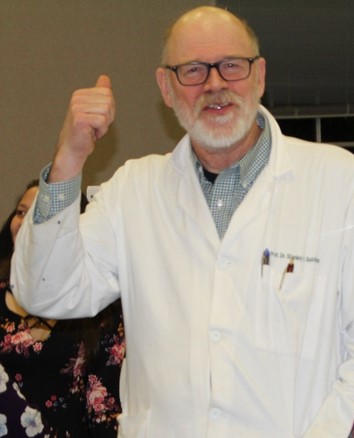 On Hartwick College Week: Regenerating lost heart tissue would be a boon to our health.
On Hartwick College Week: Regenerating lost heart tissue would be a boon to our health.
Stanley K. Sessions, professor of biology, looks to the salamander to find out how.
For the last 30 years, Dr. Stanley K. Sessions has worked in the Department of Biology at Hartwick College where he teaches Animal Development, Vertebrate Zoology, Genetics, and Evolution. S.K. Sessions began his career and life-long passion for salamanders at the University of Oregon, where he was an undergraduate and also worked as a laboratory technician in a developmental biology lab. Expeditions to Mexico and Costa Rica to search for Neotropical salamanders reinforced his interest, which he followed up with graduate work in the Museum of Vertebrate Zoology at the University of California Berkeley. After earning his Ph.D. at the University of California-Berkeley, Dr. Sessions worked as a postdoctoral research fellow at the University of Leicester in the U.K. to learn molecular techniques, followed by another research position at the University of California-Irvine in order to study limb regeneration in salamanders.
Sessions is internationally known for his work on the evolutionary cytogenetics on salamanders and he has produced nearly 100 publications, and presented numerous talks including at Cambridge, Cornell, and Harvard Universities.
Sessions also drew national attention for his research on Deformed Amphibians, with visits to his lab at Hartwick made by major news networks, including CNN, ABC News, and Discovery Channel.
He has also been awarded several major grants, including National Science Foundation research and STEM grants. In 2015-16, Dr. Sessions was awarded a prestigious Fulbright grant to conduct research on Blind Cave Salamanders at the University of Ljubljana in Slovenia.
Dr. Sessions continues his research on salamanders, involving Hartwick undergraduates as collaborators.
Heart Disease
Heart disease is the leading cause of death among men and women. Any of us can have a heart attack at any time with devastating consequences. Currently the main treatments for heart attack are quite limited, usually involving cardiac stents, and/or bypass surgery. Heart attack usually results in the death of heart muscle cells, leading to scarring and reduced heart function for the rest of your life. Wouldn’t it be great if we could develop a way to regenerate lost or damaged heart tissue? This is a major goal of bioengineering, one of the hottest and fastest growing areas of biotechnology. Unfortunately, humans cannot regenerate their hearts.
However, salamanders can! Recently, my students and I have discovered that a local species of salamander, the eastern newt, can undergo extreme heart regeneration. By extreme heart regeneration, I mean that if you surgically remove 50% of the ventricle, the newt will completely regenerate its heart within six weeks.
This observation leads to two important questions: First, how does the newt survive the operation? And secondly, where do the stem cells come from for regeneration? To answer the first question, we have found that a clot forms that seals the opening in the ventricle, which allows the heart to continue to function and the newt to survive the operation. In regards to the second question, by transfusing labeled blood cells from a donor newt, we have found that stem cells for heart regeneration come from blood cells trapped in the clot.
By identifying the genes that allow salamanders to regenerate their hearts, we hope to contribute to the development of better treatments for heart disease in humans.

Comments
One response to “Stanley K. Sessions, Hartwick College – Heart Disease”
This is incredible. I want to build this into my “extremophile” unit that I’m doing with my Extreme Earth Science class. Can you direct me to where I can get more information??
Thanks,
Bronwyn Niece
[email protected]